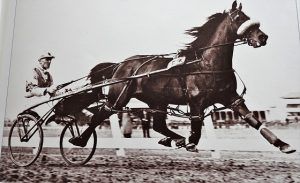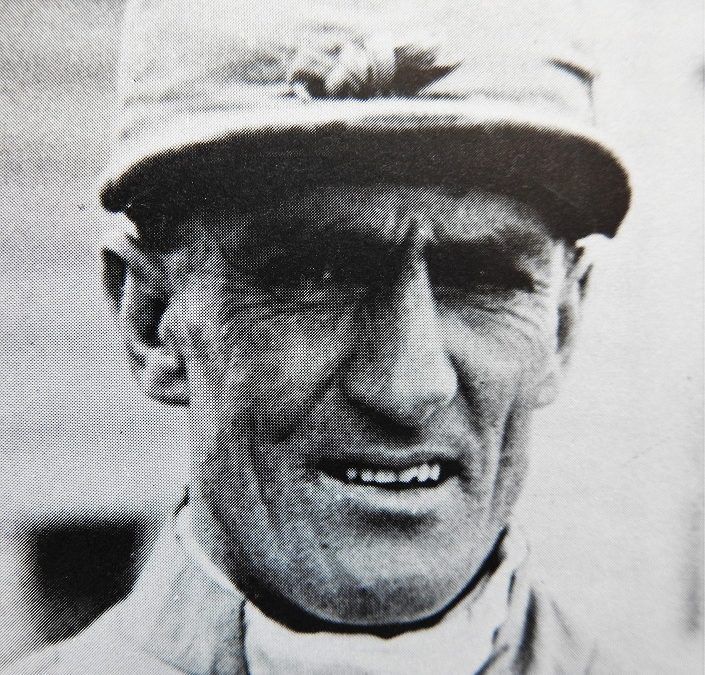It is surprising how many harness racing personalities served time in a gallops stable. For some, like Maurice and Freeman Holmes it was family based, their father having been a legendary figure in both codes.
Maurice Holmes, it is not generally realised, served an apprenticeship with his father before switching back to the standardbred side of the double gaited stable on the Racecourse Rd corner at Riccarton. Jimmy Bryce and Max Stewart driving premiership winners in later years were both apprenticed jockeys and Stewart,winner also of three harness training premierships when later based in the north,rode successfully for several years in the south before switching to harness racing. His harness career was still near peak when he died suddenly from heart failure campaigning in Australia in his 50’s.
Even Dexter Dunn, a sensation from a later era, spent time riding out for Peter and Dawn Williams but like Freeman (F G) Holmes wasn’t the right weight or height to pursue a professional career path.
In between there were many who left racing for the harness world,usually because of weight considerations or for practical reasons, and in return several well known harness trainers took their skills to the thoroughbred world as has become the fashion again in recent times.
Dil (M B) Edwards was notably successful in both fields. He was the leading harness trainer of 1927 when a young man and a decade later was winning Group races at Riccarton and Trentham from the famous Yaldhurst stables and training pacing stars like War Buoy.
Freeman Holmes senior was for many years the best known “convert” .He had been a talented rider from the late 1870’s when so light the extra weight he carried in a race -and not always lead bags,sometimes bits of iron-meant he struggled to get up into the saddle. He gained most fame riding Manton at the 1885 NZ Cup meeting when the three year old won all the features -The NZ Cup,the NZ Derby and the Canterbury Cup.
He later handled the champion jumper Liberator, a legend of the 1890’s whose plates adorned the wall of his Riccarton home for over 70 years,and married Mary the daughter of the leading Riccarton trainer William Webb.
He mixed codes for many years and was most influential on the breeding side of harness racing as well with his famous imported stallions and major race winners. He won only one premiership but remained a giant among harness figures most of his life.
A real racing character of earlier days was Arthur Julian known always as “Tartar” for reasons never explained. He was the leading jumps rider one season, a good flat rider and when retired from the gallops was one of Auckland’s leading harness trainers for many years based at Ellerslie and later Alexandra Park. Besides being a remarkable judge of pace and a fine conditioner, Tartar was a canny horseman one of the best known and most popular of his time. He travelled widely over the North Island to trial jumpers when active in that role such was his expertise in assessing their progress.
A famous “import” from the galloping code was Doug Watts one of the best known of drivers in the “Golden Age”. Watts was a leading apprentice jockey who learned the racing game from two masters; Bill Dwyer a very astute trainer from Wanganui and, when Watts swapped codes,Jock Henderson of Oamaru a shrewd operator, historically underrated, whose strike rate was outstanding and his success with “lost causes” was well known.
Watts then moved to Canterbury where his successes included an Inter Dominion Final with Massacre in a masterly drive and 7 successive winners on an 8 race programme at Reefton in 1954.
A retiring personality and a serious approach to his work made Doug one of the most sought after free lancers of his time and stable driver for the even more astute Vic Leeming. The pair were once delayed leaving an Addington meeting because a host of demonstrators outside made it unsafe to do so.There were few better brains in trotting than Doug Watts and for many years in retirement he was a patrol steward at Addington.
One of the most successful of the crossover jockeys at both codes was Roy Berry developer of several champions.While he never won a trainer’s premiership -largely because of the numbers he raced and travelled-he was right in contention most years and was the leading driver of 1938.
Roy (actually Royden) ( pictured) had a colourful career. He served his time with Freeman Holmes and was the most successful jockey of all mentioned here, at one stage riding in Sydney where he had a fair measure of success.A lightweight for most of his career he was often in contention for the riding premiership and though suffering from weight problems in later years and occasionally falling foul of officialdom, for he was a fearless rider.
He won the 1913 NZ Cup at Riccarton,then our premier race, on Sinapis,who famously walked over the hill from Lyttleton (led by Berry ) the day before the race after her travel arrangements were wrecked by a seamen’s strike. He later rode her in a Sydney Cup.
A rather silly action involving war conscription (he had actually volunteered years earlier for the first Echelon) sidelined him for a time and he went farming with a brother before taking up the harness game in the 1920’s.
In no time at all it seemed he became a headline trainer and was recognised as the best saddle rider in the harness game-popular events in that era.
Berry was notably successful with horses with physical or attitude problems. Southern Chief, a top young horse with some bad habits -”He wants to kick and doesn’t want to work” Berry once said of him-won 7 races for the stable after he took over his training. He had notable success with Parisienne, a remarkable racemare who won an Inter Dominion (on points) at Addington in 1938 and trained dual NZ Cup winner,Lucky Jack, for both successes. He had a long list of star performers a number of them lifted considerably in race ability under his care to take major races. Horsepower and Pacing Power- a near champion-were other stars and he won the 1944 NZ Cup only months after taking over Bronze Eagle after a domestic upheaval among his previous owners.

The Mighty Springfield Globe, with Roy Berry who won a small fortune while leasing him to race here
A stable assistant for many years,Dave Welsh,once detailed for the writer the exhaustive detail which went into Bronze Eagle’s Cup programme,the horse being from a family generally believed to be better sprinters than stayers. He was driven by George Noble,Roy opting for his old favourite Pacing Power who finished third. It was a masterclass of Cup preparation.
Roy also trained the Australian pacer stranded in New Zealand during WW2, Springfield Globe.He leased the stallion,won many races with the near champion (nowadays a “superstar”),who after finally returning home was 6 times the “colonial bred” leading sire of New Zealand.
Unfortunately Berry suffered from the same health handicap that had shortened the life of Dil Edwards -severe asthma- and both paid a heavy price for continuing to keep up a busy racing schedule. At times both had to be helped in and out of cart on work mornings and the treatments Berry adopted to continue his schedule undoubtedly shortened his life.He died aged 50 in 1945 though the male Berry line had not been generally long livers. That he had established such a record in both codes by that time was extraordinary.His only son,John,was also a successful trainer often with descendants of Springfield Globe including semi-classic age group races with Super Globe,Gay Lyric, and later stud sire Henry of Navarre.
